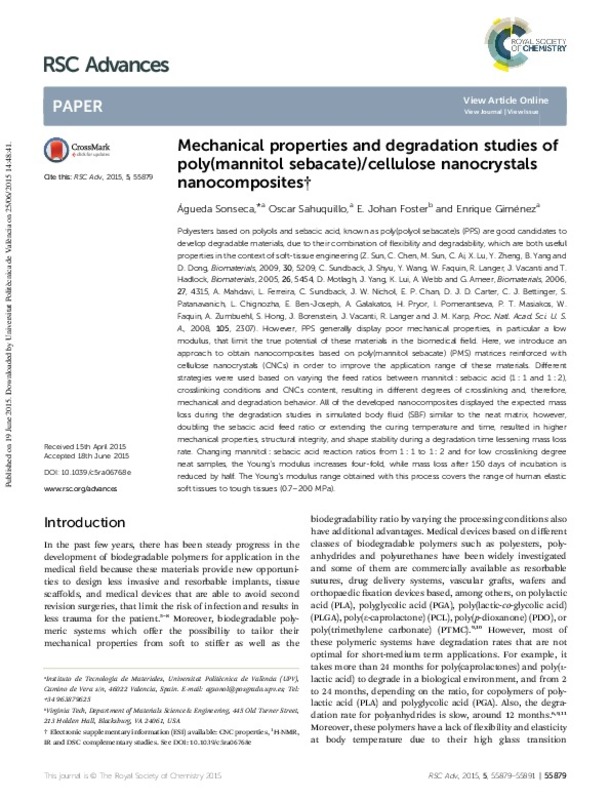JavaScript is disabled for your browser. Some features of this site may not work without it.
Buscar en RiuNet
Listar
Mi cuenta
Estadísticas
Ayuda RiuNet
Admin. UPV
Mechanical properties and degradation studies of poly(mannitol sebacate)/cellulose nanocrystals nanocomposites
Mostrar el registro sencillo del ítem
Ficheros en el ítem
| dc.contributor.author | Sonseca Olalla, Agueda
|
es_ES |
| dc.contributor.author | Sahuquillo, Oscar
|
es_ES |
| dc.contributor.author | Foster, E. Johan
|
es_ES |
| dc.contributor.author | Giménez Torres, Enrique
|
es_ES |
| dc.date.accessioned | 2017-12-21T13:58:41Z | |
| dc.date.available | 2017-12-21T13:58:41Z | |
| dc.date.issued | 2015 | es_ES |
| dc.identifier.issn | 2046-2069 | es_ES |
| dc.identifier.uri | http://hdl.handle.net/10251/93303 | |
| dc.description.abstract | [EN] Polyesters based on polyols and sebacic acid, known as poly(polyol sebacate) s (PPS) are good candidates to develop degradable materials, due to their combination of flexibility and degradability, which are both useful properties in the context of soft-tissue engineering (Z. Sun, C. Chen, M. Sun, C. Ai, X. Lu, Y. Zheng, B. Yang and D. Dong, Biomaterials, 2009, 30, 5209, C. Sundback, J. Shyu, Y. Wang, W. Faquin, R. Langer, J. Vacanti and T. Hadlock, Biomaterials, 2005, 26, 5454, D. Motlagh, J. Yang, K. Lui, A. Webb and G. Ameer, Biomaterials, 2006, 27, 4315, A. Mahdavi, L. Ferreira, C. Sundback, J. W. Nichol, E. P. Chan, D. J. D. Carter, C. J. Bettinger, S. Patanavanich, L. Chignozha, E. Ben-Joseph, A. Galakatos, H. Pryor, I. Pomerantseva, P. T. Masiakos, W. Faquin, A. Zumbuehl, S. Hong, J. Borenstein, J. Vacanti, R. Langer and J. M. Karp, Proc. Natl. Acad. Sci. U. S. A., 2008, 105, 2307). However, PPS generally display poor mechanical properties, in particular a low modulus, that limit the true potential of these materials in the biomedical field. Here, we introduce an approach to obtain nanocomposites based on poly(mannitol sebacate) (PMS) matrices reinforced with cellulose nanocrystals (CNCs) in order to improve the application range of these materials. Different strategies were used based on varying the feed ratios between mannitol : sebacic acid (1 : 1 and 1 : 2), crosslinking conditions and CNCs content, resulting in different degrees of crosslinking and, therefore, mechanical and degradation behavior. All of the developed nanocomposites displayed the expected mass loss during the degradation studies in simulated body fluid (SBF) similar to the neat matrix, however, doubling the sebacic acid feed ratio or extending the curing temperature and time, resulted in higher mechanical properties, structural integrity, and shape stability during a degradation time lessening mass loss rate. Changing mannitol : sebacic acid reaction ratios from 1 : 1 to 1 : 2 and for low crosslinking degree neat samples, the Young's modulus increases four-fold, while mass loss after 150 days of incubation is reduced by half. The Young's modulus range obtained with this process covers the range of human elastic soft tissues to tough tissues (0.7-200 MPa). | es_ES |
| dc.description.sponsorship | The authors gratefully acknowledge financial support received from Spanish Ministry of Economy and Competitiveness (Project MAT2010/21494-C03), as well as the support of FPU grant from MED (MED-FPU; AP2009-2482) and the Adolphe Merkle Foundation. | es_ES |
| dc.language | Inglés | es_ES |
| dc.publisher | The Royal Society of Chemistry | es_ES |
| dc.relation.ispartof | RSC Advances | es_ES |
| dc.rights | Reconocimiento - No comercial (by-nc) | es_ES |
| dc.subject.classification | CIENCIA DE LOS MATERIALES E INGENIERIA METALURGICA | es_ES |
| dc.title | Mechanical properties and degradation studies of poly(mannitol sebacate)/cellulose nanocrystals nanocomposites | es_ES |
| dc.type | Artículo | es_ES |
| dc.identifier.doi | 10.1039/c5ra06768e | es_ES |
| dc.relation.projectID | info:eu-repo/grantAgreement/MECD//AP2009-2482/ES/AP2009-2482/ | es_ES |
| dc.relation.projectID | info:eu-repo/grantAgreement/MICINN//MAT2010-21494-C03-01/ES/DESARROLLO DE ESPUMAS Y SISTEMAS RIGIDOS CON MEMORIA DE FORMA BASADOS EN NANOCOMPUESTOS BIODEGRADABLES NANONOESTRUCTURADOS/ | es_ES |
| dc.rights.accessRights | Abierto | es_ES |
| dc.contributor.affiliation | Universitat Politècnica de València. Departamento de Ingeniería Mecánica y de Materiales - Departament d'Enginyeria Mecànica i de Materials | es_ES |
| dc.description.bibliographicCitation | Sonseca Olalla, A.; Sahuquillo, O.; Foster, EJ.; Giménez Torres, E. (2015). Mechanical properties and degradation studies of poly(mannitol sebacate)/cellulose nanocrystals nanocomposites. RSC Advances. 5(69):55879-55891. https://doi.org/10.1039/c5ra06768e | es_ES |
| dc.description.accrualMethod | S | es_ES |
| dc.relation.publisherversion | http://doi.org/10.1039/c5ra06768e | es_ES |
| dc.description.upvformatpinicio | 55879 | es_ES |
| dc.description.upvformatpfin | 55891 | es_ES |
| dc.type.version | info:eu-repo/semantics/publishedVersion | es_ES |
| dc.description.volume | 5 | es_ES |
| dc.description.issue | 69 | es_ES |
| dc.relation.pasarela | S\292961 | es_ES |
| dc.contributor.funder | Ministerio de Ciencia e Innovación | es_ES |
| dc.contributor.funder | Ministerio de Educación, Cultura y Deporte | es_ES |








